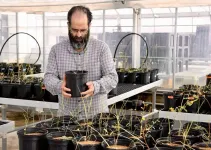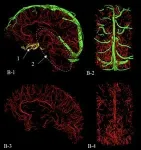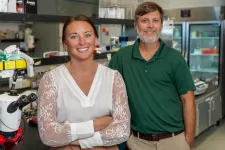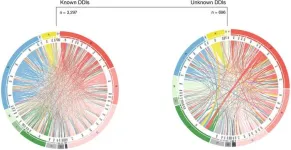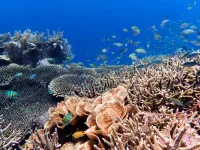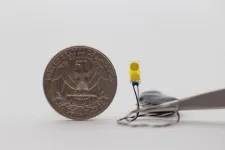(Press-News.org) A new report by the Intergovernmental Platform on Biodiversity and Ecosystem Services (IPBES) presents major findings on the gravity of impacts from invasive alien species on our planet. Researchers found more than 37,000 alien species have been introduced by human activities over the centuries, and this conservative estimate is rising at unprecedented rates. Additionally, more than 3,500 of these are harmful invasive alien species, impacting humans, animals and plants.
Dozens of international biodiversity researchers are authors of the report, including University of Houston Associate Professor of Biology and Biochemistry Martín Nuñez, who was a coordinating lead author of the chapter covering the impacts of invasive species.
“This is the greatest collection of information ever created on the impacts of invasions,” Nuñez said. “We found that the impacts are huge and bigger than we expected. We have about 13,000 references on this topic to compile a huge database.”
Approved on Saturday, Sept. 2 in Bonn, Germany, by representatives of the 143 member States of IPBES, the “Invasive Alien Species Assessment: Summary for Policymakers” finds that alongside dramatic changes to biodiversity and ecosystems, the global economic cost of invasive alien species exceeded $423 billion annually in 2019, with costs having at least quadrupled every decade since 1970.
“Invasive alien species have been a major factor in 60% and the only driver in 16% of global animal and plant extinctions that we have recorded,” said Anibal Pauchard, co-chair of the assessment.
Invasive species affect food supplies, as evidenced by the negative impacts of the European shore crab on commercial shellfish beds in New England and the damage caused by the Caribbean false mussel to fishery resources in India.
There also impacts on people’s health, including diseases such as malaria, Zika and West Nile Fever, spread by invasive alien mosquito species like Aedes albopictus and Aedes aegyptii. Invasive alien species also damage livelihoods, for example in Lake Victoria where fisheries have declined due to the depletion of tilapia, because of the spread of water hyacinth, the world’s most widespread terrestrial invasive alien species.
The report shows that 34% of the impacts of biological invasions were reported from the Americas, 31% from Europe and Central Asia, 25% from Asia and the Pacific and about 7% from Africa. Most negative impacts are reported on land (about 75%), with considerably fewer reported in freshwater (14%) and marine (10%) habitats. Invasive alien species are most damaging on islands, with alien plants now exceeding native plants on more than 25% of all islands.
Prevention measures, such as border biosecurity and strictly enforced import controls, are identified in the report as having worked in many instances, such as the successes achieved in Australia, New Zealand and neighboring islands in reducing the spread of the brown marmorated stink bug.
Preparedness, early detection and rapid response are shown to be effective at reducing rates of alien species establishment. Eradication has been successful and cost-effective for some species, especially when their populations are small and slow spreading in isolated ecosystems such as islands. For example, the black rat and rabbit have been successfully eradicated from French Polynesia.
“Our recommendations are not policy prescriptive,” Nuñez said. “We are helping policy makers, but we are not telling them what to do; we are offering options.”
For the full press release from the IPBES and facts and figures from the report: https://www.ipbes.net/IASmediarelease
END
University of Houston researcher aids in creation of groundbreaking report on invasive species
Report finds invasive alien species play key role in 60% of global plant and animal extinctions
2023-09-07
ELSE PRESS RELEASES FROM THIS DATE:
CAR-T-cell therapy without side effects? Hollings researchers show results in preclinical models
2023-09-07
When Richard O’Neil, Ph.D., joined MUSC Hollings Cancer Center two years ago, he knew that he wanted to continue finding ways to make CAR-T-cell therapy easier on patients.
What he didn’t expect was that a side project – worked on by Megan Tennant, a graduate student in his lab, as a way to keep busy while a key piece of equipment was being serviced – would potentially open up this treatment beyond the world of cancer.
“I don't think that either of us expected that first initial experiment to work,” Tennant said. “But when we saw how well it worked and really started to conceptualize where this could go and how important ...
The timing of fireworks-caused wildfire ignitions during the 4th of July holiday season
2023-09-07
Every year on the 4th of July, fireworks cause cause a precipitous increase of wildfire ignitions in the United States (U.S.). This human-environmental phenomenon is noteworthy and highlights the impact of American culture on wildfire activity in the U.S. In other regions of the world, research has increasingly shown that human culture impacts fire activity, with weekly cycles of fire activity reflecting the local structures of workweeks and the timing of religious days of rest (e.g., Saturdays and Sundays). Although 4th of July peak in wildfire igntions has ...
Dosage tweaks may hint at undiscovered interactions between medications
2023-09-07
Analysis of data from more than 1 million Danish inpatients identifies nearly 4,000 drug pairings that are associated with more frequent dosage adjustments when prescribed together—potentially hinting at previously undiscovered drug interactions. Søren Brunak of the University of Copenhagen, Denmark, and colleagues present these findings in the open-access journal PLOS Digital Health.
In some cases, especially among elderly populations, a person may be prescribed several different medications at once in order to treat one or multiple health conditions—a phenomenon known as polypharmacy. Polypharmacy is associated with increased health risks due to the potential ...
How bright-light treatment improves sleep in stressed mice
2023-09-07
Chronic stress is associated with sleep disturbance. In their new study, Lu Huang and colleagues identify the neural pathway behind this behavior, and at the same time, explain how bright-light treatment is able to counter it. The research was conducted in mice at Jinan University in China and published September 7th in the open access journal PLOS Biology.
Bright-light treatment is known to improve sleep in those with sleep disorders, but how it works – and whether it works in cases of stress-induced sleep disturbances – was unknown. The researchers hypothesized that a part of the brain called the lateral habenula is deeply involved in this phenomenon because ...
Lack of evidence hampers progress on corporate-led ecosystem restoration
2023-09-07
A ‘near total’ lack of transparency is making it impossible to assess the quality of corporate-led ecosystem restoration projects, according to a Lancaster University-led study published today in Science.
Efforts to rebuild degraded environments are vital for achieving global biodiversity targets. The United Nations has launched a Decade on Ecosystem Restoration, and in recent years businesses around the world have collectively pledged to plant billions of trees, hundreds of thousands of corals and tens of ...
Implantable device enables earlier detection of kidney transplant failure in rats
2023-09-07
An implantable sensor provided advanced warning of kidney transplant failure in rats as much as several weeks earlier than commonly used biomarkers of kidney function, researchers report. The device, tested in a rat model of kidney transplantation, provides real-time continuous monitoring of organ temperature and thermal conductivity, detecting inflammatory processes associated with graft rejection. Although lifesaving for patients with end-stage kidney disease, long-term kidney transplantation survival remains a major challenge. Graft failure ...
2022 Hunga-Tonga eruption triggered fast and destructive submarine volcanic flows
2023-09-07
In 2022, the eruption of the submerged Hunga Tonga–Hunga Ha apai volcano triggered a fast-moving and destructive underwater debris flow that severed telecommunication cables and reshaped the surrounding seafloor. The findings – representing some of the first fieldwork to document what happens when large volumes of erupted volcanic material are delivered directly into the ocean – provide new insights into the behavior and hazards of submerged volcanoes. Explosive volcanic eruptions on land create pyroclastic flows of hot ash and rock that, when they reach the ocean, can trigger damaging ...
Are large corporations upholding their conservation promises?
2023-09-07
Large transnational corporations (TNCs) are positioning themselves as environmental leaders, carrying out environmental restoration projects that go beyond their legal obligations. However, some corporations oversell their efforts. In this Policy Forum, Timothy Lamont and colleagues present an evaluation of sustainability reports of 100 of the world’s largest businesses, revealing the extent to which TNCs are claiming to contribute to, but failing to report on, ecosystem restoration. “Increased rigor, consistency, transparency, and accountability are needed to ensure that corporate-led restoration delivers quantifiable, ...
Nudging food delivery customers to skip the fork drastically cuts plastic waste, study shows
2023-09-07
In 2021, more than 400 million metric tons of plastic waste were produced worldwide, and it is predicted that the world’s plastic waste growth will continue to outpace the efforts to reduce plastic pollution in the coming decades. As food delivery services became increasingly popular during the COVID-19 pandemic, the surge in plastic waste generated by single-use cutlery has become a key environmental challenge for many countries. A new study finds “green nudges” that encouraged customers to skip asking for cutlery with their delivery orders were dramatically successful and could be a powerful policy tool to reduce plastic waste.
“Few policies target plastic waste ...
First device to monitor transplanted organs detects early signs of rejection
2023-09-07
A body can reject a transplanted organ at any time — even decades later
Signs of rejection must be caught early to intervene, preserve the organ
Current monitoring methods are intermittent, imperfect and sometimes invasive
New implant offers continuous monitoring by tracking the organ’s temperature
When temperatures change, an alert is sent to a smartphone or tablet in real time
EVANSTON, Ill. — Northwestern University researchers have developed the first electronic device for continuously monitoring ...
LAST 30 PRESS RELEASES:
Air pollution exposure and birth weight
Obstructive sleep apnea risk and mental health conditions among older adults
How talking slows eye movements behind the wheel
The Ceramic Society of Japan’s Oxoate Ceramics Research Association launches new international book project
Heart-brain connection: international study reveals the role of the vagus nerve in keeping the heart young
Researchers identify Rb1 as a predictive biomarker for a new therapeutic strategy in some breast cancers
Survey reveals ethical gaps slowing AI adoption in pediatric surgery
Stimulant ADHD medications work differently than thought
AI overestimates how smart people are, according to HSE economists
HSE researchers create genome-wide map of quadruplexes
Scientists boost cell "powerhouses" to burn more calories
Automatic label checking: The missing step in making reliable medical AI
Low daily alcohol intake linked to 50% heightened mouth cancer risk in India
American Meteorological Society announces Rick Spinrad as 2026 President-Elect
Biomass-based carbon capture spotlighted in newly released global climate webinar recording
Illuminating invisible nano pollutants: advanced bioimaging tracks the full journey of emerging nanoscale contaminants in living systems
How does age affect recovery from spinal cord injury?
Novel AI tool offers prognosis for patients with head and neck cancer
Fathers’ microplastic exposure tied to their children’s metabolic problems
Research validates laboratory model for studying high-grade serous ovarian cancer
SIR 2026 delivers transformative breakthroughs in minimally invasive medicine to improve patient care
Stem Cell Reports most downloaded papers of 2025 highlight the breadth and impact of stem cell research
Oxford-led study estimates NHS spends around 3% of its primary and secondary care budget on the health impacts of heat and cold in England
A researcher’s long quest leads to a smart composite breakthrough
Urban wild bees act as “microbial sensors” of city health.
New study finds where you live affects recovery after a hip fracture
Forecasting the impact of fully automated vehicle adoption on US road traffic injuries
Alcohol-related hospitalizations from 2016 to 2022
Semaglutide and hospitalizations in patients with obesity and established cardiovascular disease
Researchers ‘listen in’ to embryo-mother interactions during implantation using a culture system replicating the womb lining
[Press-News.org] University of Houston researcher aids in creation of groundbreaking report on invasive speciesReport finds invasive alien species play key role in 60% of global plant and animal extinctions
